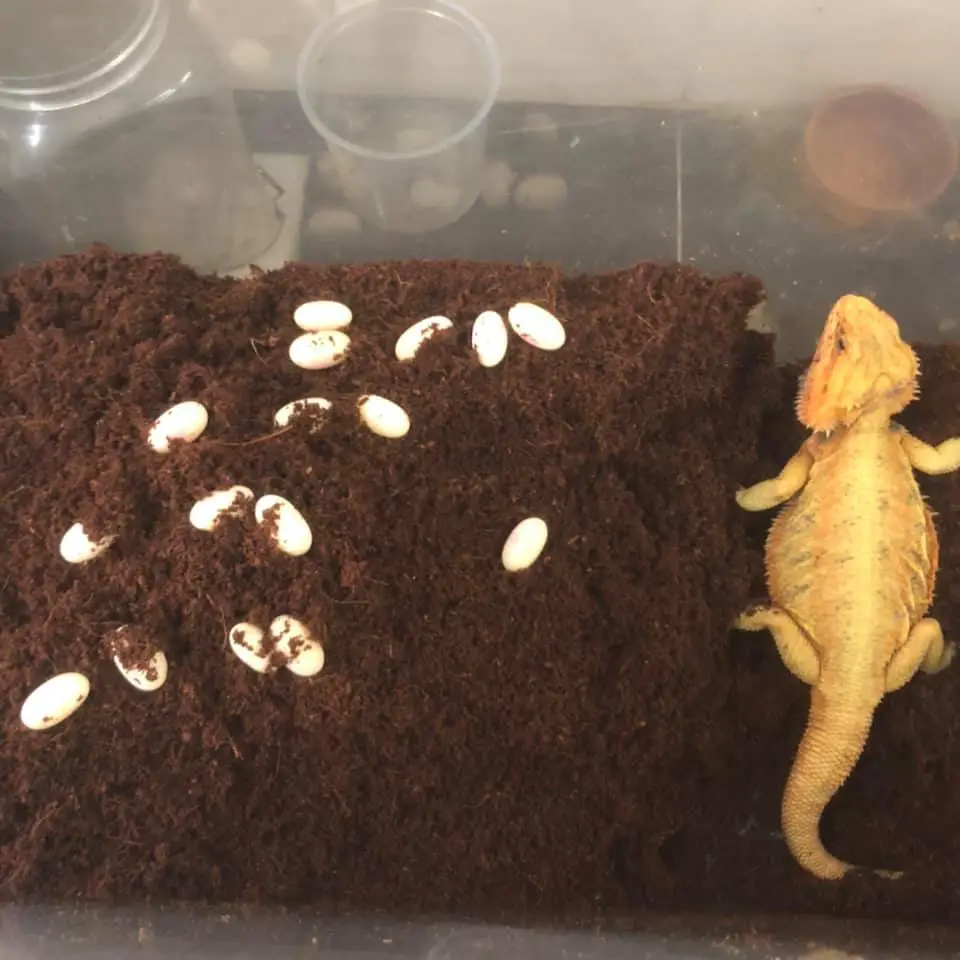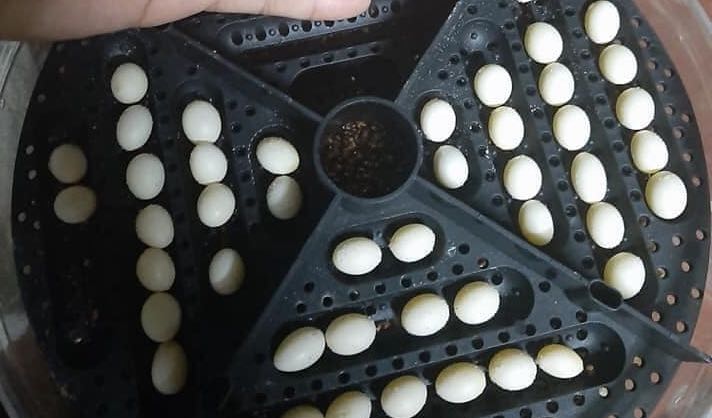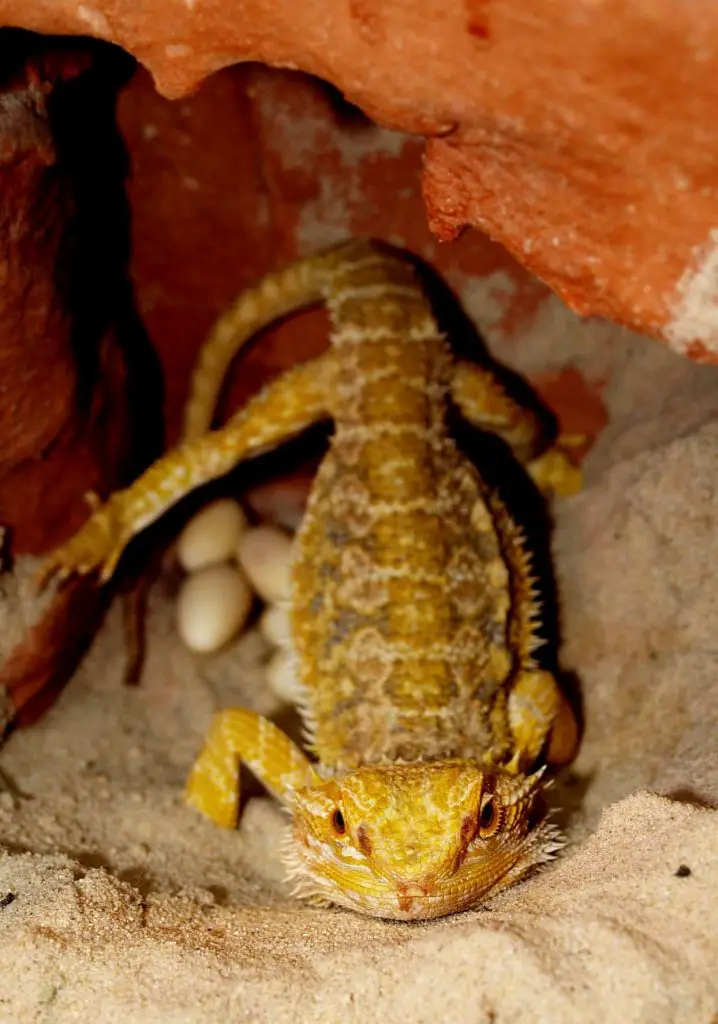Egg laying is typical behavior in female bearded dragons. Typically, a female dragon can lay between 1-6 clutches per pregnancy. Each clutch contains 20 eggs.
A female beardie will still lay eggs but infertile, even if there are no males around. It is necessary to check if the eggs are dead or sterile. Otherwise, it will be a waste of time to incubate such eggs; they will not give you a hatchling anyway.
In this short article, I’m going to show you how to tell if bearded dragon eggs are dead, and more. Enjoy reading.
Contents
What Do Bearded Dragons Eggs Look Like?

Bearded dragon eggs are small and oval-shaped; the females lay the eggs in groups known as clutches. The eggs are primarily white or cream.
Both the fertile and infertile bearded dragon eggs will express different colors during the candling process. Fertile eggs show a pinkish color after putting a bright light behind it. On the other hand, infertile eggs show a yellow color upon passing the light through them.
The Signs of Good Bearded Dragon Egg (Fertile)

How can you tell if a bearded dragon egg is fertile? The significant and convenient way to check whether the eggs are fertile or infertile is through candling. It is done when the eggs are 1-2 weeks old. Here is how to go about the candling process.
- Obtain the eggs from the nesting box.
- Mark each egg on top with a pencil and carefully return them in the same position. It prevents you from turning the eggs, which can lead to spoilage.
- Carry the eggs and take them to a dark place/ room.
- Obtain each egg at a time for observation.
- Pass the light through the egg by placing the egg in front of the light source. You can use any light available to you, like a torch, bulb, etc. Ensure the bulb has a low watt to prevent a sudden rise in temperature in the egg that can destroy the growing embryo.
- Do the same to all the eggs. Here is a video on How to check if your eggs are fertile.
If the egg is fertile, the light coming through it appears pink; you can see a network of blood vessels or a pink embryo.
New to bearded dragon? Check out the bearded dragon care sheet now! We had listed out all the things you need to know about bearded dragons as pets. Check it now!
Also, fertile eggs will hatch after an average of two months during incubation. When the embryo begins to grow and develop, a healthy fertile egg expands and grows up to twice its original size.
During incubation, a fertile egg will turn chalk-white; it is a good indication that the egg will hatch into healthy hatchlings.
How to Tell if Bearded Dragon Eggs are Dead
For accurate and reliable findings, it is better to leave the eggs for about two weeks after laying before assessing it for fertility. To check whether your beardie eggs are dead or not, you need to candle them through a flashlight.
Take the eggs in a dark room and perform the candling process, as we have seen above. Upon passing the light, dead eggs do not exhibit veins nor a pinkish glow because there is no more blood flow.
Regular inspection is needed when the eggs are incubating. In the candling process, you may notice some eggs are yellow, pink or green, and they tend not to grow. Those eggs might be dead.
Another way to tell whether the egg is dead is through water waving tests? The test involves putting the beardie egg in cool water. If the egg is dead, then it does not waver.
But it is recommended to leave them to incubate to term as long as they are not moldy.
How Long Does It Take a Bearded Dragon Egg to Hatch?

Generally, a healthy and fertile bearded dragon egg will take around 55-75 or 80 days to hatch when adequately incubated. The incubation time varies based on humidity and temperature.
The incubation time tends to prolong when the temperatures inside the incubator box cool. 1-1.5 days before hatching, the eggs may start to collapse and appear to have small droplets of water. It is an indication that hatching is about to happen.
Some people tend to worry and think the eggs to be infertile when they observe such signs, but it is not always the case.
The majority of the eggs will hatch the same day, but others can delay up to three days. When hatching, the neonates come out after 24-36 hours after they have sliced the shell with their egg tooth.
There have been cases where some neonates possess a soft and pink flesh attached to the belly after hatching, which many people may take to be an injury. But it is a normal thing, and soon it will disappear. The neonate reabsorbs it for nutrition purposes.
Do all Bearded Dragon Eggs Die if They Haven’t Hatched After Incubation?
Not all eggs will hatch at the same time. Some eggs delay before hatching, while others may not hatch at all after a couple of days after incubation.
New to bearded dragon? Check out the bearded dragon care sheet now! We had listed out all the things you need to know about bearded dragons as pets. Check it now!
It is recommended you allow those eggs that do not hatch to remain in the incubator for several days just in case.
If the eggs do not hatch still, don’t try to open them. The survivability of the baby inside will be low if it cannot get itself from the egg. It will still die even if you assist it to get out.
Some eggs that remain in the incubator will hatch after a couple of days, and healthy neonates emerge. It is not all eggs that will die after the incubation period is over before they hatch. They will need some extra time.
Signs of an Infertile Bearded Dragon Egg
If you hold the egg in front of a bright light and see nothing inside, and the egg appears yellow, then it is infertile.
A female beardie tends to lay only a single clutch if the eggs are infertile. Infertile eggs cannot hatch; it is good to discard them.
Infertile eggs have a smaller dimension. Also, in case you incubate them, they don’t swell like the fertile ones but retain the original size.
Yellowing and oozing signs show that the egg is infertile.
Other Signs of Dead Lizard Eggs that are Relevant
Dead and unhealthy lizard eggs can get moldy. If you have infertile eggs in the incubator from the start, the eggs tend to sink and grow mold.
Large cracks or the presence of minimal areas of webbed crackling could indicate that the egg is dead.
You may notice an egg deflating, no sweating, and the shell feels tough when still in the incubator. It could probably be dead.
Frequently Asked Questions
Are the bearded dragon eggs soft or hard?
A good and healthy egg feels firm and soft when touched and has a smooth white tinge to them right away after hatching takes place.
Why are my bearded dragon eggs collapsing?
The right temperature and humidity for incubated eggs are 80-85℉ and 75%, respectively. When the figures are correct, and it is not yet hatching time, then you notice that the eggs are collapsing, they are probably infertile.
How long does it take a bearded dragon egg to hatch?
A fertile bearded dragon egg typically takes 55-75 days to hatch when the temperature and humidity level is correct. The low temperature inside the incubator box will prolong hatching.
Can bearded dragon eggs hatch without an incubator?
Hatching can take place with or without an incubator if the eggs are fertile. You can hatch the eggs in natural soil or set up a DIY incubation system using a plastic box.
Conclusion
Well, there you have it. You now know how to tell if bearded dragon eggs are dead and why it is vital to assess the fertile and infertile eggs.
Candling is a fast and straightforward process that gives you excellent results during the assessment. Always avoid too much handling of the eggs and rotating them around; the life inside could perish.

One of my eggs broke open and the bearded dragon was dead why my temperature was right on and Iam worried about the other eggs what can I do.